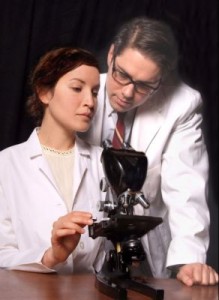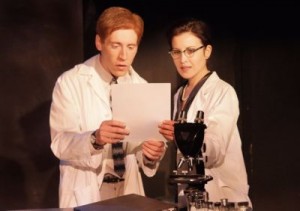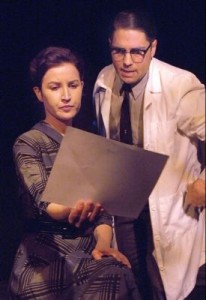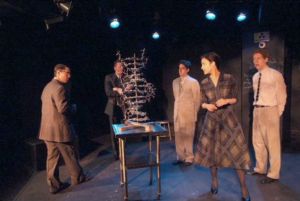
In an ironic twist of fate, Dr. Rosalind Franklin, the woman who should have shared the 1962 Nobel Prize for the discovery of DNA’s double helix structure received no recognition whatsoever from the Nobel Foundation. True, the Foundation does not award the prize posthumously, and Dr. Franklin had died four years earlier. No, the real irony is that Rosalind Franklin died without even knowing her part in this world-changing discovery.
Interesting as this historical tidbit might be, it would hardly seem food for a fast-moving, funny, suspenseful, and ultimately deeply moving train ride of a play, or so I thought when planning my March and April calendars. Despite the Fountain Theatre’s track record as the only intimate theater to have won the Ovation Award for Best Production a record four times, Anna Zeigler’s Photograph 51 sounded like it might be too esoteric (and maybe even dull) for my tastes.
Wrong! Like the rest of the sold-out house (on a Thursday no less!), I was thrilled, enthralled, amused, and moved by this absolutely smashing ninety minutes of simply great theater.
The year is 1951, and 30-year-old Rosalind Franklin (the stunningly lovely and gifted Aria Alpert) arrives to begin work with the even younger molecular biologist Dr. Maurice Wilkins (Daniel Billet), only to learn that he expects her to work under and not beside him. “I will not be anyone’s assistant,” declares Rosalind, and when Maurice (pronounced Morris) dares to address her by her first name, she wastes no time in correcting him. “My name is Rosalind, but you can call me Miss Franklin … or Dr. Franklin.”
Like Rodney Dangerfield, women scientists in un-liberated early 1950s England got no respect. Only men were allowed to eat in the Senior Common Room, and even though Rosalind’s student Raymond Gosling (Graham Norris) tries to make her feel better by reminding her that “it’s not that biophysicists have the best conversations at lunch,” from this moment on, it will be war between the understandably defensive Rosalind and the sincere but ever-bumbling Maurice. The poor man can’t help but keep putting his foot in his mouth whenever face to face with the beautiful but icy Rosalind. His attempt to begin again from scratch by acting out a scene from A Winter’s Tale, a play which he almost happened to see the same evening Rosalind saw it, awakens only Rosalind’s further disdain. A later effort to win Rosalind over with a box of chocolates is an even more dismal failure, Rosalind turning a simple gift into an interrogation. The earnest young scientist tries so hard yet gets nothing for his efforts but words like, “I’m not your wife” and “You don’t have to win me over” and “I don’t want to be your friend.”
Rosalind finds some comfort in exchanging letters with American scientist Don Caspar (Ross Hellwig), who tries to reassure her that it’s worse for women scientists in America, and she relaxes by “disappearing” from time to time into the Swiss Alps, but for the most part Rosalind’s life is spent in the laboratory.
Meanwhile Maurice meets U.S. molecular biologist wiz kid Dr. James Watson (Ian Gould) when the American, who like Maurice wants to get into the race for DNA, is virtually the only one interested in a presentation given by the Englishman on nucleic acids.
From this point on, it’s a contest to see which team of scientists will make the crucial discovery first. With Rosalind and Maurice not speaking to each other except through intermediary Graham (a very funny scene, beautifully played by Alpert, Billet, and Norris), the colleagues-turned-rivals agree to work separately, she on Form A, he on Form B, while in another part of England, Watson and fellow molecular biologist Francis Crick (Kerby Joe Grubb) pursue their own investigations.
There is joy in Rosalind’s lab when an x-ray diffraction photo, the titular and justly famed Photograph 51 reveals “a perfect X”, a helix—an incredible, joyous discovery and a chance for Rosalind to “issue a death notice” to Maurice’s Form A. Without her knowledge, though, Maurice informs Watson and Crick of her findings, a fact never to be discovered by Rosalind during her all too brief lifetime, and an injustice which Ziegler’s play attempts to rectify in the most entertaining of fashions.
Director Simon Levy deserves highest marks for his work here, not only for guiding his sextet of actors to such finely-tuned performances but also for keeping the stage ever alive with activity as the discovery of the double helix nears.
As is so often the case in biographical films and plays, the cast at the Fountain rates considerably higher on the looks scale than did their historical counterpoints (not that there’s anything wrong with that). Fortunately, in every case, acting talent matches good looks, beginning with Alpert, who gives an absolutely commanding, charismatic performance—and is on stage virtually every second of the play’s ninety minute running time. Alpert’s eyes come alive with Rosalind’s passion for science, and her scenes with Billet positively crackle, Rosalind’s mastery of irony and sarcasm turning the otherwise confident Maurice into a bumbling mess of a man. Billet perfectly captures graying-before-his-time stick-in-the-mud Maurice in the most endearing of ways—to everyone but the fair Rosalind.
A dryly delightful Norris gets many of the best lines—and laughs—as Rosalind’s well-meaning assistant, caught between the two warring scientists and doing his best to survive. Tall, handsome Hellwig provides the perfect counterpoint to Maurice’s blundering nerdiness, all the while revealing the American scientist’s warmth, tenderness, and good heart in his scenes opposite Alpert. Gould gives an energetic, animated performance as Watson, the wild-haired science prodigy who used Rosalind’s Photograph 51 without giving her credit for it, and Grubb does solid, believable work as Watson’s older partner in discovery.
The entire cast deserves credit for learning not only their lines but also the scientific knowledge which allows them to jot down formula upon formula and diagram upon diagram on the black walls of Travis Gale Lewis’ simple but effective set, filled with scientific paraphernalia of the era by Dean Cameron.
Kathi O’Donohue’s lighting is, as always, excellent, highlighted by a particularly stunning moment in which she floods Watson and Crick’s double helix model with light as if from heaven above. Shon LeBlanc’s period costumes, Peter Stenshoel’s sound design, and Judi Lewin’s hair and makeup combine to create a vivid depiction of the play’s time and setting, and dialect coach JB Blanc has helped cast members playing Brits with their very authentic-sounding accents.
Photograph 51 captures the joy and excitement felt by scientists on the verge of both discovery—and the fame and financial gain that can come from it. It is also a pair of love stories, one between characters whose first meeting comes long after they have begun a mail correspondence, the other an unrequited one which leads to a powerful, poignant scene which imagines what might have happened if Maurice had only gone into the theater that night instead of merely passing by.
Don’t let Photograph 51’s scientific subject matter deter you from experiencing about as funny, thrilling, and moving a theatrical experience as you’re likely to have in any L.A. theater this spring, if not this year. Photograph 51 is an exciting ride indeed.
Fountain Theatre, 5060 Fountain Ave., Los Angeles.
www.fountaintheatre.com
–Steven Stanley
April 30, 2009
Photos: Ed Krieger






 Since 2007, Steven Stanley's StageSceneLA.com has spotlighted the best in Southern California theater via reviews, interviews, and its annual StageSceneLA Scenies.
Since 2007, Steven Stanley's StageSceneLA.com has spotlighted the best in Southern California theater via reviews, interviews, and its annual StageSceneLA Scenies.







 COPYRIGHT 2024 STEVEN STANLEY :: DESIGN BY
COPYRIGHT 2024 STEVEN STANLEY :: DESIGN BY